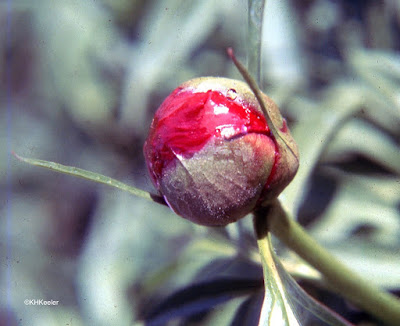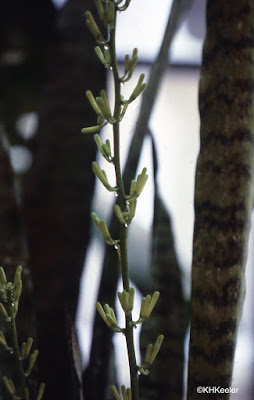Plants With Extra Floral Nectaries
Peony buds secrete nectar (sugar water).Which attracts the ants. Why do peony buds secrete nectar? There is no definitive answer to that question, but, based on studies of other plants, to attract ants which defend the plant from damage.
 |
| Ants taking nectar from peony extrafloral nectaries. |
 |
| Drop of nectar on peony bud (upper right) |
Nectar (sugar water)-producing glands on plants are called nectaries. Flowers frequently contain nectaries, providing nectar as the food that pollinators seek and in the process pollinate the flower. A nectary on a bud can't be part of pollination because the flower isn't open yet (photos above). Such nectaries are easier to observe than to understand. They are called extrafloral nectaries. The term is a little awkward but the idea is that they secrete nectar but are not part of pollination.
What do they do? In most cases where they have been studied, they are part of the plant's defense against animals that would eat it (herbivores).
 |
Ant on extafloral nectary at the base of the
leaf of beach morning glory Ipomoea pes-caprae |
The animals most commonly seen at extrafloral nectaries are ants. Ants collectively are the biggest predators in most ecosystems--they don't seem that way because individually they are so small. Furthermore, this subdivided predator can be in many places at once. Ants are always looking for meat to take back to the nest to feed their larvae. Adult ants, the foragers, don't eat meat. Sugars are important in their diet and foragers will happily pause in their search for dead animals and animals small enough to kill for their larvae to drink nectar for themselves.
 |
| Extrafloral nectar drop on morning glory bud |
The result is that, just like the nectar within flowers attracts animals that pollinate, nectar on the surface of plants attracts small predators that will attack animals that they find on the plant. Studies that excluded ants or otherwise were able to study plants with extrafloral nectaries with and without ants generally showed greater herbivore damage to the plants without ants.
I expect that in the wild, in say, China, ants or other nectar-feeders protect the buds of peonies from attacking moth larvae, grasshoppers or other herbivores.
 |
Look carefully: a bee and wasp are visiting the
extrafloral nectaries on this peony |
Extrafloral nectaries have so far been found on nearly 4000 plants, about 1-2% of flowering plants. They occur on virtually every above-ground part of the plant but are particularly common on the outside of flower buds and the vulnerable points at the base and underside of leaves. Generally they are more common in plants of warmer climates. In addition to ants, wasps, predatory beetles and other small predators visit extrafloral nectaries and have been shown to confer protection to the plant.
My Ph.D. research was done in Costa Rica, investigating the function of the extrafloral nectaries on the tropical morning glory
Ipomoea carnea. Ants at the extrafloral nectaries on the outside of the flowers (see above) reduced damage to both flowers and seeds compared to plants without ants. Mine is one of the studies that show nectary-visiting ants provided the plant with protection from herbivores.
 |
Shiny drops of extrafloral nectar below the buds
on the tropical morning glory Ipomoea carnea |
I worked on extrafloral nectaries off and on over my career. That included collecting information to make a "World List of Plants with Extrafloral Nectaries" to look for patterns in the distribution of this plant character. Extrafloral nectaries are topic I know so much about that it is hard for me to write a reasonable blog. That explains why this is the first I've talked about extrafloral nectaries in more than three years of blogging. For a blog on extrafloral nectaries, I have to summarize things about which I'd love to bore you with the details.
Marjorie Weber, now of Michigan State University, and I analyzed the patterns in my World List of Plants with Extrafloral Nectaries a few years ago...it was great to use powerful computer analysis to identify patterns in a data set I'd been creating for more than 30 years. Of course, I'd published similar analyses in the distant past, and as we learn more and develop better tools, no doubt in the future someone will update our analysis. That's part of the fun of scientific research.
 |
Extrafloral nectaries on the
flowering stalk of Sansevieria |
The extrafloral nectaries on peony buds are probably the place where the most people have noticed ants visiting extrafloral nectaries. Until someone looks at damage with and without visiting ants, preferably in a wild native peony population, we can only say the explanation is
most likely that the nectar is there to attract ants which deter something from damaging the buds. While that is probably the explanation for the extrafloral nectaries and ants on peony buds, plant ecologists always prefer to have a careful, controlled experiment test each suggested explanation and it hasn't been done.
That we only infer what is going on is in fact very common. There are an estimated 325,000 flowering plants. Most of them have never had anyone study anything about them. So we generalize from the few careful studies of pollinators or root growth or nutrient uptake or... I know there are thousands of studies of many topics, the problem is when you ask about a particular plant in a particular place often the answer is "hasn't been studied." The best we can do is to assume that the results of similar studies answer the question. Usually we are right but every so often we get a surprise. Biologists love those surprises, because they teach something new about nature. So forgive me if I enjoy hedging about peony extrafloral nectaries: "Why do peony buds secrete nectar? There is no definitive answer to that question, but, based on studies of other plants, to attract ants which defend the plant from damage."
Look at nature and wonder about what you see!







Where's the list?
ReplyDelete